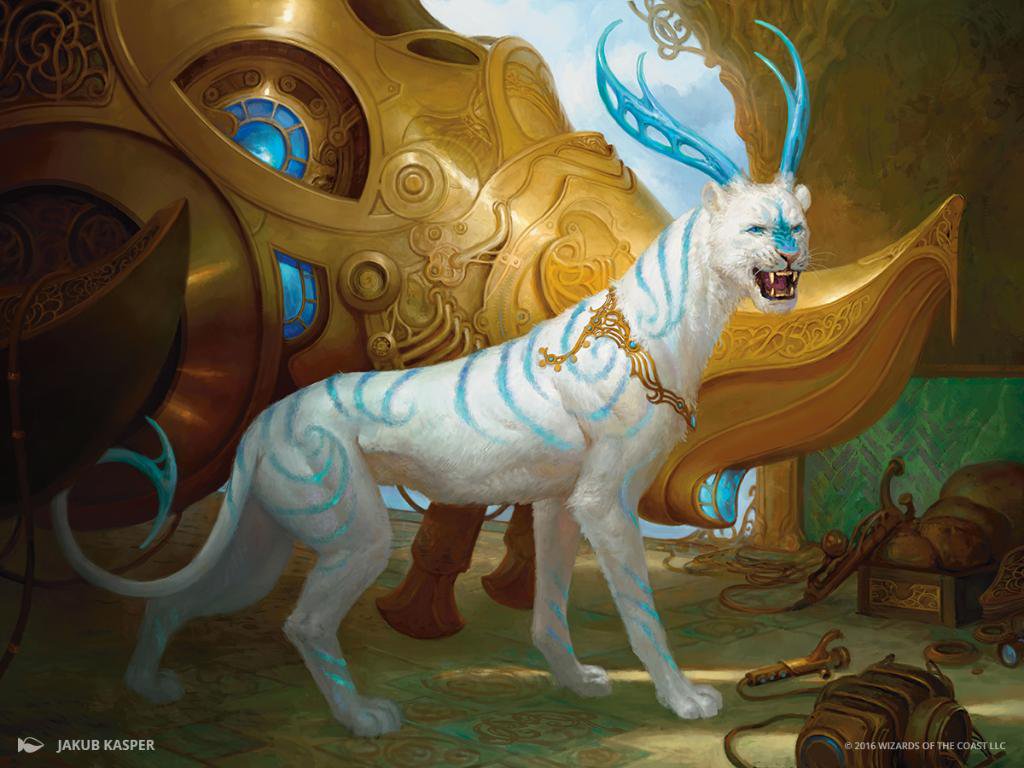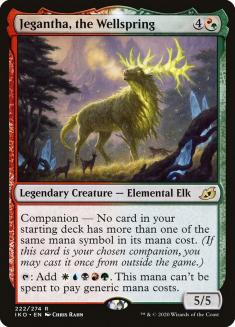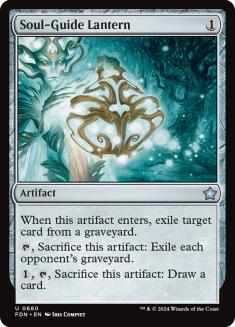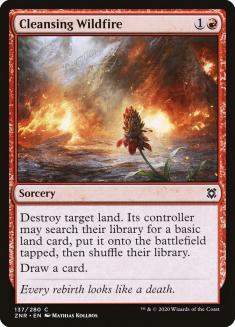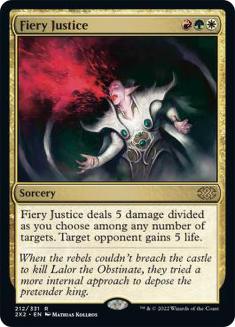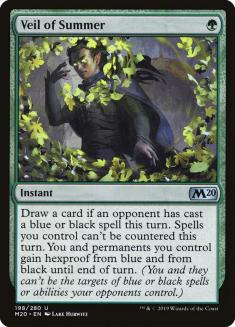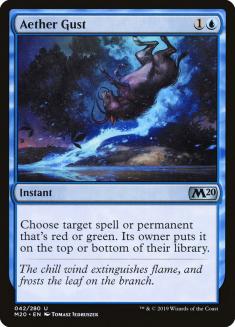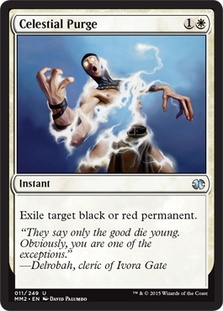I know what you’re thinking…
“Ben, why has there never been a deck where Jegantha, the Wellspring was anything more than a strange Colossapede?”
“Ben, why can’t there be fun decks in Modern anymore?”
“Ben, I want a midrange deck that’s also a combo deck!”
I want these things too. I want to get excited about tuning my decks again. I want to make powerful, but not overwhelming plays. I want to have a hand full of awesome ways to gain powerful advantages and to enjoy the interplay between my strong cards and my opponents’.
Modern has often walked a fine line between powerful, interactive greatness and non-interactive solitaire. I’m pleased to announce that at this particular point in time, we are witnessing a great format. We have some of the most interesting and interactive Magic available in a format where the best decks are multicolored, rich with heavy hitters, full of strong proactive and reactive spells, and blessed with powerful-yet-flexible sideboard options.
While my colleague Shaheen Soorani explored the nearly-infinite options in the generic Four-Color decks that now comprise the better portion of the new control segment of Modern, I’m excited to investigate the combo-midrange blend of Four-Color Copy Cat. The differences between them are minor at first glance, but they invite a significant divergence in gameplans, which makes them particularly exciting.
Creatures (9)
Planeswalkers (12)
Lands (25)
Spells (14)

Where Four-Color Control aims to extend the game to the point where its powerful landfall end-game of Felidar Retreat and/or Field of the Dead takes over, Four-Color Copy Cat just wants to cast the best possible spells from Turn 2 forward, slamming bombs until something sticks and runs away with the game. Incidentally, it forces the opponent to play down some amount of mana in order to protect themselves against an instant win via infinite Felidar Guardians, all the while dropping game-winning spells like Omnath, Locus of Mana or Uro, Titan of Nature’s Wrath. Heck, even Wrenn and Six is a massive beating against just about every non-combo deck in the format!
I love a deck where you can just slam your heavy hitters over and over again while your opponent frets about the possibility of you executing a combo. This is what made Splinter Twin great, and it’s a recipe we should always be looking for in our best decks. Imagine if Jund had an infinite combo grafted into it? This is the closest Modern has ever gotten to that dream scenario.
This is the best kind of archetype for Magic in 2020. It’s a multifaceted midrange deck where you force your opponent to answer disparate threats that require specific answers just to maintain parity. For example, Uro requires a counterspell and incidental graveyard hate to avoid falling behind on some mix of land drops or card advantage. Wrenn and Six immediately gains a card with its +1 ability as early as the second turn, and without either a counterspell or a high-powered creature to immediately answer it, the opponent gets quickly buried. Omnath requires a counterspell or else it will gain a card and quickly snowball out of control with life and mana.
Even Felidar Guardian offers synergy outside of its combo applications. As we all know, it’s superb with various planeswalkers as a way to gain an extra use of their abilities in the same turn. It’s stellar with Oath of Nissa, and even great with Omnath.
Sadly, Saheeli Rai is the odd card out in this deck, without much to do other than scry and create a distraction for the opponent. It can copy an Omnath for an extra card, but other than that you’re rarely getting much utility outside of the infinite combo. Such is life when Arcum’s Astrolabe leaves the format!
However, even this isn’t a tragedy. Why? You can sideboard her out whenever you want and turn your deck into a midrange pile while the opponent worries about sideboarding in ways to interact with your combo. Imagine how foolish your Humans opponents will look when they sideboard in Dismember, Auriok Champion, or Plague Engineer to stymie your combo, only to lose to a few loops of Uro, a Fiery Justice, and a Wrenn and Six emblem? Heck, even Jegantha, the Wellspring attacks for a healthy five damage at a time, and can win the game just as well in Modern as a Colossapede does in Limited.
Speaking of Jegantha, it’s surprisingly useful in this deck, more so than in almost every other deck that has ever included it. Why? Four-Color Copy Cat actually has a use for (almost) all of the mana Jegantha produces, whether that’s casting an Omnath or a Teferi, Time Raveler alongside a Wrenn and Six.
Additionally, in a number of mid-game scenarios, Four-Color Copy Cat often finds itself with excess mana without something impressive to do with it. In these scenarios, a free 5/5 creature to cast out of the companion spot is actually a meaningful piece of the gameplan. It’s wonderful to have a card available for free that acts as both a mana source and a way to use extra mana, all in one. Magic in 2020 practically demands that you have cards like this available to you if you want to compete. Uro, Titan of Nature’s Wrath is one example of the phenomenon, but Jegantha also merits consideration.
Now, it’s important to discuss the sideboard of this deck, debate different inclusions, and understand what we need to include in order to cover our expected matchups. Clearly, with only fourteen sideboard slots (remember Jegantha takes up one!) and a gigantic format to cover, we have to be as judicious as possible. Sideboarding is one of the important features of Constructed Magic where a skilled player can gain an edge over a less-experienced one. The proliferation of sideboard guides has bridged most of the gap, but we want to understand why we include the cards we do, so we can think critically about when they might or might not be useful.
The first spot is Soul-Guide Lantern, which maintains a single spot in the list and retains it over the best alternative, Relic of Progenitus. Frankly, I still don’t understand this decision. Relic of Progenitus is an excellent play on Turn 1 against opposing Uro Piles, acts as a repeatable source of graveyard hate (compared to Soul-Guide Lantern’s one-time utility), and blows itself up to exile graveyards and draw a card. Unless you have significant graveyard-based synergies of your own, it doesn’t make sense to me to play Soul-Guide Lantern over Relic of Progenitus.
A pair of Uros and four copies of Wrenn and Six is not a sufficient graveyard engine to merit playing Soul-Guide Lantern over Relic of Progenitus. Wrenn and Six only requires a single fetchland to keep the engine spinning, and you can almost always just time your Relic of Progenitus sacrifice right after you escape your Uro. The benefit of being able to perpetually keep your opponent’s graveyard weak off a single one-mana investment is massive. Relic, unlike Soul-Guide Lantern, is actually a legitimate piece of interaction against an opposing Wrenn and Six. I need to understand what play patterns arise more frequently that demand Soul-Guide Lantern as the hate piece over Relic of Progenitus, but as of right now, it seems like the upside of Relic is far greater than for the newer alternative.
Cleansing Wildfire is, as you all know, one of my favorite cards out of Zendikar Rising. However, as a single hate card against Mono-Green Tron and Amulet Titan, it’s worse than Damping Sphere. Without Snapcaster Mage or prowess synergies, it’s simply not as powerful. I’m not counting it out, as there is synergy with Path to Exile (once you clear out all of their basic lands, this card becomes phenomenal!). There’s also good reason to keep it against decks with Field of the Dead, but I’m not convinced quite yet.
In a Jeskai shell with multiple Snapcaster Mages and four Path to Exile, I’m slamming these in my sideboard. In this deck, the answer is less clear. Heck, even Confounding Conundrum acts as a strong hate card against opposing Omnath and Uro decks, and works wonders against Amulet Titan in its own right. Don’t commit to a card in your sideboard that may not do enough even when you want to sideboard it in. Synergy is key!
Fiery Justice, on the other hand, is exactly what we are looking for against Humans and Death’s Shadow. This is the two-for-one we always want to see. If Death and Taxes, Rakdos Death’s Shadow, or Humans should increase in metagame share, I just might include a third copy of this card. It’s that good. It’s impactful and comes in against a large slice of the metagame, which is just what we’re looking for!
Veil of Summer is an amazing card against Thoughtseize and Cryptic Command decks. That’s all there is to say about it. It comes with such incredible blowout potential that it’s worth including in some number almost universally. Incidentally, if your opponent is playing Dimir Mill, it’s also a good sideboard card there. Cheap, impactful, widely applicable sideboard cards are the best!
Aether Gust, Celestial Purge, and Mystical Dispute all have varying applications against different subsections of the Modern metagame, but I can’t help but wonder if they’re sacrificing too much impact for general utility. In a deck like this, I tend to want my interactive sideboard cards to be demoralizing for my opponent when I cast them. I don’t want them to necessarily be a simple Doom Blade or Memory Lapse, unless they can act as such against nearly all opposing decks.
For example, Celestial Purge is a stellar Doom Blade against Rakdos Death’s Shadow, but it’s meaningless against Death and Taxes or any Selesnya-based Collected Company deck. Aether Gust is a nice counterspell that gets around Cavern of Souls against Amulet Titan, and it’s a serviceable Time Ebb against Humans and Burn decks, but it does nothing against Azorius Control or the various Urzatron archetypes. Cards in our sideboards should be maximally powerful or maximally applicable.
I’d like to play a second sideboard Relic of Progenitus and a third Fiery Justice over the Celestial Purges to start, with the possibility of replacing Dovin’s Veto and/or Aether Gust with more flexible or cheaper cards. Veto, in particular, seems misplaced in a format where Teferi, Time Raveler is the most common card that gets included in opposing decks where a Negate might be desirable. I would want to cry if I ever drew a Dovin’s Veto after the opponent landed a small Teferi. At least with Aether Gust I can still tuck an opposing Wrenn and Six to attempt to interact!
Depending on what you’re worried about, either another Aether Gust or another Mystical Dispute seem better-positioned to win the fights that matter against the decks you care about.
Cats Are Back
The beauty of a deck like Four-Color Copy Cat is that it’s got a proactive gameplan, a long game with as much grindy power as any control deck in the format, and the ability to incorporate just about any interactive card you can think of in the sideboard. Whether you want to harass opposing graveyards, pack better answers for planeswalkers, or even transform into a counterspell-heavy control deck with funky cards like Spell Queller or Snapcaster Mage, you have the tools to make it happen.
There are few things that get me as excited in Modern as a new Death’s Shadow archetype, but a new Copy Cat archetype is one of them. It’s got all the tools to become the best deck in the format. Now it’s time to tune it and make that dream happen.

